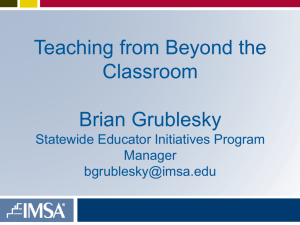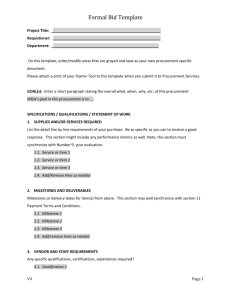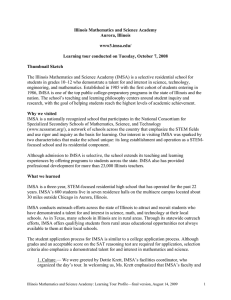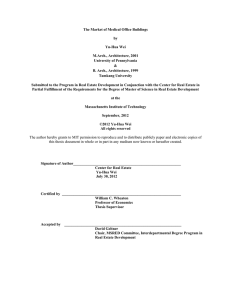Compliance Solutions
advertisement
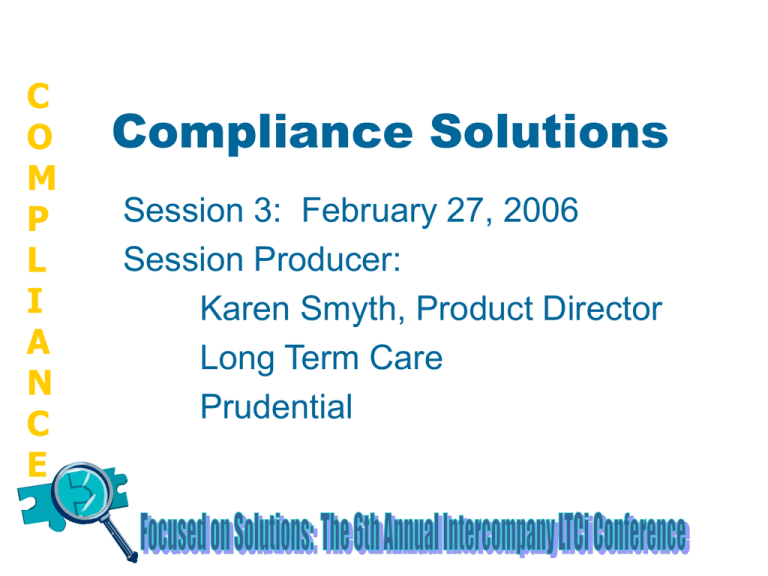
C O M P L I A N C E Compliance Solutions Session 3: February 27, 2006 Session Producer: Karen Smyth, Product Director Long Term Care Prudential C O M P L I A N C E Panelists • Maryann Glotzer, LIMRA International • Brian Atchinson, IMSA • Elizabeth Lovaas, New York Life What is LIMRA International? A member-owned organization, dedicated to meeting the information needs of companies involved in marketing insurance and investment products. Through the application of cooperative and custom research, we strive to deliver insights that help bring the complex world of financial services into focus. We know your company, your products, your business, and most importantly, compliance issues. Why a Customer Assurance Program (CAP)? Reaction to class action suits and market conduct concerns of the industry If customers misunderstand the provisions of their products -- sales practices are misleading The only way to know customers understand -- ask Why CAP? CAP is the industry standard for benchmarking customer satisfaction at time of sale. ― Endorsed by IMSA ― Over 100 companies using CAP for: • Life • Annuities • Long Term Care What is CAP? Survey of recent buyers What is CAP? Very 2 2 what Some 3 3 ry Not Ve 4 4 All Not At 5 5 mely Extre 1 was: lpful 1 like) w he e, ho oducer? ials? d the apply) rienc nds an l that expe by the pr les mater ark al tual fu ed recent d sa s, mu y? (M your ice provid tions an bond mpan on d co rip rv r se sc ocks, se m ou ts (st 1. Ba a. The oduct de d fro oduc pr se pr r t ha rc en b. Ou vestm ntly pu In ne u rece ve yo es No ply) t(s) ha nuiti oduc split that ap Ane n 7.) hat pr k all rson, etc.) estio GO ranc 2. W (Mar to qu key pe n, rance e of insu R LO any? skip (e.g., demptio e taxes, YOU ERE fe insu typ r comp re oses please e, Li me other H m ou nc s purp hip, stock offset estat sines insura nce fro to So y life For bu r, partnersity (e.g., es, etc.) insura bu e t lif no ns dolla e liquid er: u buy u did expe (If yo did yo ustom r estat probate ath nses ed C rposes Fo to cover ent expe er your de d Valu e or pu vestm d savings on final aft se an re Dear purpos an in ere uti other 's needs purcha ity to assu s t l and r what As r tax-shelt le contrib ily d? cent ed r buriar your fam r retiremen ren's 3. Fo rchase Fo a charitab ur re opportun g the ne lp cove help ovide fo money fo your child ntly pu te yo As in is he ce ia th To rv n re r pr ec g se ca ke help e you ney fo savin ath I appr like to ta itment to self. You e us ur de suranc To a way of saving mo er lif m es ter yo life in your telling anoth would our com As a way of al expens rtgage af r the up in ve ch as rvice by d to m fo of ilt As su on mo iu u bu s e ha ati s yo ll er prem educ pay off th decide b of se that ha licy I sti stom y the oney to pa of cu a better jo u recently uct. help e po M insuranc using To e you us do d how yo Life prod ar y r ne he an of mo ete why se a Real Ot licy. urces apply) compl my po hat so at purcha ived ent to 4. W ark all th t rece licy a mom e it in the op (M not ye e nce po order dr take have incom insura ts in ease aire, plac lope and We No, I rrent d life l asse 3 nn you pl . ve ncele ancia Cu vings m a ca Won't ief questioss reply en required her fin Sa ot fro y? is oney n. d your polic this br ed busine no stamp pendent is y, an M perso your rit in ed cu de os th iv me l se encl e mail — RA, an in conduct u rece d it to socia ve yo your livere to me. ents? ngs, needs? it in th ked LIM zation, to it 5. Ha ent de holdi as l comm my ag ent mailed rance to fit your tiona have ch organi Yes, e insu m y addi 1 my ag ur lif e progra or an Yes, resear for us. ze yo u nc 2 ur to yo t analy life insura survey agen No out yo other service ite ur e ab 2 fin yo ov d de ns r y impr 6. Di suggest a estio or ou ide an could to any qu can prov ur agent XXXw we ) have e out ho t yo ns ab Yes If you se or if w se contac t at (XXX estio 1 en y sugg purchaance, plea departm ve an e you ha assist er servic 7. Do ► LIMRA prints questionnaires and envelopes with the company’s logo and colors ► LIMRA mails questionnaires along with postage paid return envelopes ► LIMRA pays all mail out and return postage costs ► LIMRA sponsors a drawing to enhance response rates ► LIMRA analyzes results and provides reports Questionnaire custom. XXXX al Cordi ly, e] [nam [title] Cover letter Drawing Analysis & Imaging Percent of Life Customers Unaware They Bought Life Insurance Report Al lR eg io ns Ag en cy 1 Ag en cy 2 Ag en cy 3 Ag en cy 4 Ag en cy 5 Ag en cy 6 Ag en cy 7 Ag en cy 8 Ag en cy 9 7 6 5 4 3 2 1 0 Questionnaire Questionnaire Reports from CAP Company summary with industry norms Reports by Distribution Channel Regional, marketing, and producer-level reports Identification of any units or producers who differ significantly from overall company results Name, address, and policy numbers of every policyholder who indicates a significant misunderstanding Additional Information from CAP Electronic images of returned surveys in client’s own handwriting Most Comments are Positive! I just wanted to say I love my agent Mike @ your office in Claremore, OK. He’s the best!! Heather K. Benefits of Using CAP Monitors sales practices without disrupting sales process ― post-sale so does not diminish producer productivity Prompt reinforcement with policyholders ― reinforcing the reasons for buying immediately after sale can improve persistency ― elicit complaints before they fester into grievances Communicates expectations ― survey content shows producers what company expects its customers to understand about their purchase Benefits of Using CAP (Continued) Independent administration ― provides an arm’s length unbiased analysis and plaintiff lawyers cannot contend company is auditing itself Industry benchmark ― provides standard against which to judge performance ― strength in numbers ― CAP User’s Group and CAP Connection Using CAP CAP tells you: Which customers are confused What they’re confused about Who or what confused them Using CAP Analyze the exceptions ― ― ― ― Do you need to contact the client? Do you need to contact producer? Do you need to contact a supervisor? Do you need to contact marketing? Using CAP Establish procedures Document all actions Document responses to those actions Forward information to anyone who might be interested Using CAP Publish procedures Copy producers on communications with their clients Copy supervisors on communications with their producers Using CAP Track activity by regions, production units, and by producers Communicate the results to the regions, production units and producers Encourage interest Using CAP Defend producers from frivolous complaints Defend against insurance department actions Defend against law suits Publish your successes Questions? Compliance Solutions: IMSA Assessments Brian K. Atchinson February 27, 2006 Anaheim, California “The secret of life is honesty and fair dealing . . . if you can fake that, you've got it made.” Groucho Marx What Is IMSA? • Independent, nonprofit standards-setting organization. • Promotes high ethical standards in the marketing, sales and service of individual life insurance, long-term care insurance and annuities. Why IMSA? • Organized in early 1990s; a response to crisis of consumer confidence in the insurance industry. • Provides rigorous, measurable, national standards. • Identifies problems early before they become widespread. Principles of Ethical Market Conduct 1. To conduct business according to high standards of honesty and fairness and to render that service to its customers which, in the same circumstances, it would apply to or demand for itself. 2. To provide competent and customerfocused sales and service. 3. To engage in active and fair competition. Principles of Ethical Market Conduct 4. To provide advertising and sales materials that are clear as to purpose and honest and fair as to content. 5. To provide for fair and expeditious handling of customer complaints and disputes. 6. To maintain a system of supervision and review that is reasonably designed to achieve compliance with these Principles of Ethical Market Conduct. IMSA Qualification To qualify, a company: • Develops and implements policies and procedures in support IMSA’s Principles. • Conducts an extensive self-assessment. • Undergoes an independent review conducted by an IMSA-qualified assessor. • Documents compliance with the six key principles, a minimum of 144 separate criteria. Suitability Needs-based Selling IMSA: Compliance Solution Needs-based selling. • Evaluate a customer’s insurable needs and financial objectives. • Use of fact-finding tools. • “Suitability” determined through needs-based selling. IMSA: Compliance Solution Producer supervision. • Adequate screening and background checks. • Adequate training and supervision. • Data collection and ongoing monitoring and review. IMSA: Compliance Solutions Clear and fair advertising, marketing, and sales materials. • Maintain consistent advertising review procedure. • Materials are easy to understand. Proper disclosure. • Compliance with laws and regulations on advertising, unfair trade practices, sales illustrations, etc. IMSA: Compliance Solution Fair and expeditious complaint handling. • Written and verbal complaints. • Track underlying problems to address systemic issues. Ethics = Commitment to Continuous Improvement 2006 IMSA Standards Update Value of IMSA IMSA-qualified companies have: • Fewer complaints. • Lower lapse and surrender rates. • Higher financial ratings. Georgia State University Study, 2005/2006 www.imsaETHICS.org C O M P L I A N C E IMSA in Practice Beth Lovaas, AIRC, MBA New York Life Insurance Company February 27, 2006 C O M P L I A N C E Agenda • • • • • • • • • IMSA topics Membership Company approach Self-assessment process Independent assessment process Sample certification timeline Examples of improvement LIMRA CAP Conclusion C O M P L I A N C E IMSA Topics: Suitability • Efforts to determine product suitable for customer • Evidence of suitability guidelines • Communicate to agents and encourage use in sales process • Submission of suitability review with application C O M P L I A N C E IMSA Topics: Distributor and Employee Training • Company products and operations • Company policies and procedures • Replacement, suitability, fair competition, advertising and sales materials, complaints, illustrations • Compliance with laws and regulations • Marketing and sale of products • IMSA Principles of Ethical Market Conduct C O M P L I A N C E IMSA Topics: Licensing • Appropriately qualified • Licensed and appointed • Meet applicable continuing education requirements • Assure that distributors do not place business or receive commission if not properly licensed and appointed C O M P L I A N C E IMSA Topics: Advertising and Sales Materials • Process for review, approval, and use of materials • Communicate requirements to distributors • Make materials available to distributors • Maintain compliance with laws and regulations related to advertising • Track and dispose obsolete materials C O M P L I A N C E IMSA Topics: Replacements • Provide customers with information to make decisions, including state disclosures • Communicate company’s policy and guidelines to distributors, including commissions • Identify and process replacements • Detect undisclosed internal replacements • Monitor agent activity IMSA Topics: Laws and Regulations C O M • Process for tracking and implementing P laws and regulations by effective date L • Communicate to employees and I distributors A N • Update policies and procedures to reflect changes in laws and regulations C E C O M P L I A N C E IMSA Topics: Complaints • Communicate complaint handling procedures • Inform customers of how to communicate complaints • Handle complaints from state departments of insurance • Monitor complaint trends C O M P L I A N C E IMSA Topics: Oversight and Monitoring • Enhanced systems and procedures to supervise and monitor compliance with laws and regulations, IMSA, and company codes of conduct and take corrective action • Monitor customer satisfaction with products and sales practices • Monitor and analyze replacement activity and take appropriate action • Enhanced training for distributors and employees on covered products, Principles and Code, and laws and regulations • Use LIMRA Customer Assurance Program surveys C O M P L I A N C E Continuous Improvement 1. Policies and Procedures 6. Act Upon 5. Monitor Continuous Improvement 2. Responsibilities 3. Communication 4. Used C O M P L I A N C E Membership • NYL founding member • NYL certified since 1998 and LTC initially certified in 2001 • Membership renewed every three years • Continued compliance with Principles and Code • Certification process is vigorous assessment of company practices in light of Principles and Code Strategy C O M • Corporate Compliance Department – Overall recertification P – Provide support and guidance L I • Life, Annuity, and LTC Business Areas A – Complete self-assessment document N – Respond to independent assessor C requests and coordinate on-site visit E C O M P L I A N C E Self-Assessment Process • Performed in-house by NYL team • Evaluate existing policies and procedures to – Extent revised in last three years; and – Confirm data provided in prior assessment is accurate • Review best practices recommendations from prior assessment and document where and how incorporated into procedures • Provide report to assessor C O M P L I A N C E Self-Assessment Tools • • • • • Organizational chart Interview guide Responsibilities matrix Training matrix Supporting documentation C O M P L I A N C E Independent Assessment Process • Qualified assessor • Review self-assessment report • Perform evaluation to determine if reasonable basis for NYL’s conclusions • Test and sample data and information • Submit report and recommendation C O M P L I A N C E • Sample Certification Timeline Self-Assessment: December 2003 – January 2004 • Update 2001 information (responsibilities matrix, interview guide, documentation) • Corporate Compliance visit 12/10 – 12/11 • For each topic, show that have P&Ps, someone is responsible, how P&Ps are communicated, evidence of use of P&Ps, monitor and measure use, and actions to keep P&Ps current • Identify and eliminate any reportable gaps • Independent Assessment: February 2004 • NYL provide self-assessment report to assessor • Review materials and develop interview questions • Provide NYL progress report including actions needed Sample Certification Timeline C O M P L I A N C E • Independent Assessment: Mid-March 2004 • Request sample files on New Business, Licensing, Replacements, Advertising and Sales/Illustrations, and Complaints • Provide checklists of information seeking for each topic • Provide progress report on findings and actions needed • Independent Assessment: April 2004 • Conduct on-site visits for 3 - 4 days • Conduct interviews, walk-throughs, testing, and review of sample files • Analyze findings and report recommendations for improvement to management • Submit reports to IMSA C O M P L I A N C E Examples of Improvement • Educate management of good practices • Enhance employee knowledge – Regulatory requirements – Complaint handling • Improve regulatory tracking and implementation • Improve new business process – Suitability – Replacement – Agent licensing, appointment and CE C O M P L I A N C E LIMRA LTC CAP Survey • LTC send monthly data file to LIMRA • LIMRA send survey to all customers that retain policy after 30-day free look has expired • Surveys sent of about 500 – 700 • Response rate about 28% • LTC receive policy flags, management report, and agent activity report • Flagged policies of 20 - 60 • LTC review and analyze policy flags and forward to others C O M P L I A N C E LIMRA LTC CAP Survey • Corporate Compliance notify Managing Partner of flagged policies • Managing Partner contact agent to follow-up with client • Result of contact documented and forwarded to Corporate Compliance • If no response after period, information forwarded to Agency Standards for handling C O M P L I A N C E Questions
